The SilverStone SX700-LPT SFX 700W PSU Review
by E. Fylladitakis on September 30, 2016 9:00 AM EST- Posted in
- Cases/Cooling/PSUs
- PSUs
- SilverStone
- SFX
External Appearance
While the SX700-LPT obviously is very small compared to an ATX PSU, it does not actually adhere to SFX specifications either. It is being labeled as an "SFX-L" design, with its chassis measuring 125 × 63.5 × 125 mm (W×H×D). Essentially, it is 25 mm longer than a standard SFX PSU. The longer chassis allowed SilverStone to fit more components and a 120 mm cooling fan, but it could very easily cause compatibility issues with some cases that do not have any extra space behind the PSU.
The chassis is sprayed with a satin black paint that is fingerprint resistant. Oddly, SilverStone punched their company logo along the top side and placed the sticker with the electrical specifications and certifications on the left side of the chassis. It is likely that the company expects the top of the PSU to be more frequently visible than its side, but such aesthetic improvements are of questionable value on such products, as cases that require SFX PSUs rarely have windowed panels anyway.
The rear of the SX700-LPT is somewhat interesting in its own way. There is only an AC cable receptacle and an on/off switch, yet such a switch is relatively rare on SFX designs. The connectors for the modular cables can the seen at the front side of the unit, with the PCI Express cable connectors being blue and every other connector being black.
Internal Design
Zhen Poweryear is the supplier of the thin 120 mm fan found inside the SX700-LPT. It has a black frame but semi-transparent tinted blades. We could not find specific information on the PY-12015H12S, but it appears to be a sleeve bearing engine fan and has a maximum speed of about 1700 RPM.
Most of SilverStone’s SFX PSU designs come from Enhance, but this is not the case with the SX700-LPT, which is a Sirfa design. Naturally, everything is very densely packed due to the limited space, but the design is actually very clean for a high power SFX unit. The filtering stage begins at the back of the AC receptacle and continues on the main PCB, with four Y capacitors, three X capacitors and two filtering inductors in total.
The heatsink at the far right side of the PCB holds the active PFC components, two transistors and a diode. Rubycon supplies the PFC 420V/390μF capacitor. The main inversion stage is a half-bridge configuration with two MOSFETS, which are found on the heatsink near the center of the design. The secondary side conversion MOSFETs are at the underside of the PCB, while DC to DC conversion circuits can be seen on the vertical daughterboards. Nippon Chemi-Con supplies all of the secondary capacitors, electrolytic and solid-state alike.


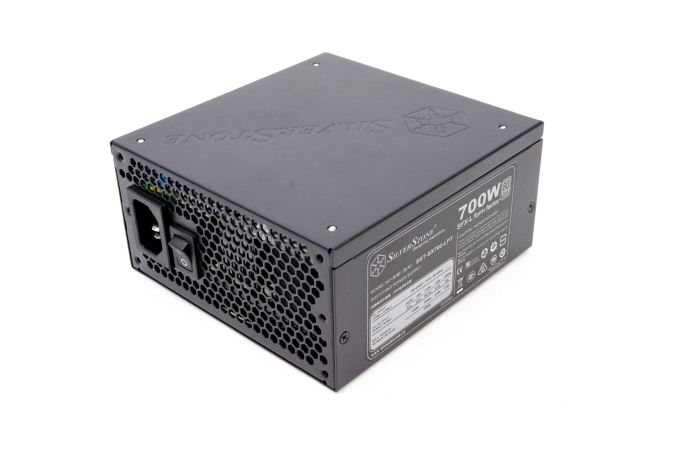
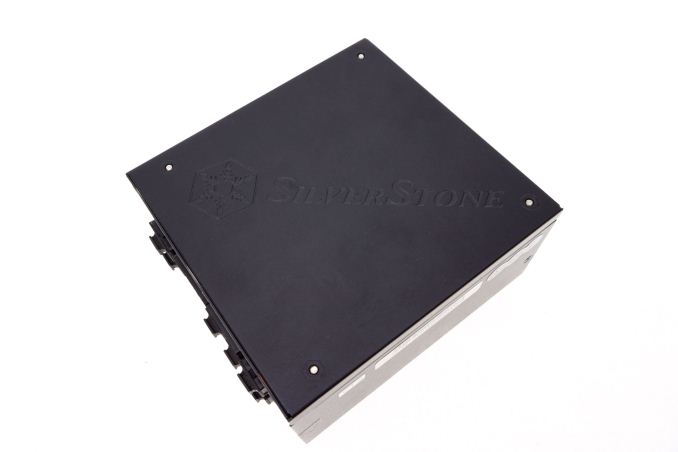



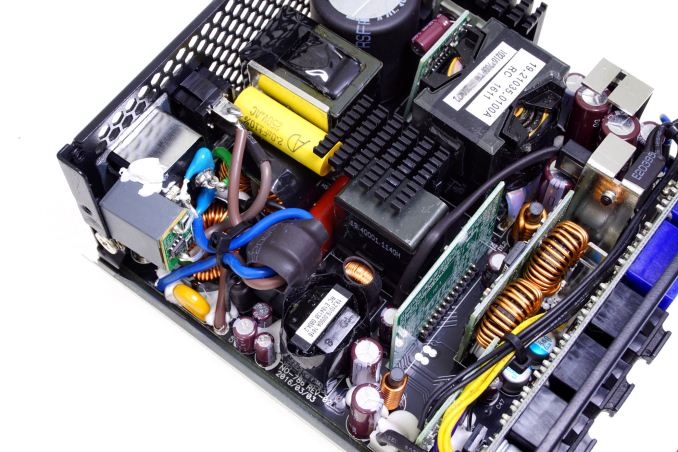
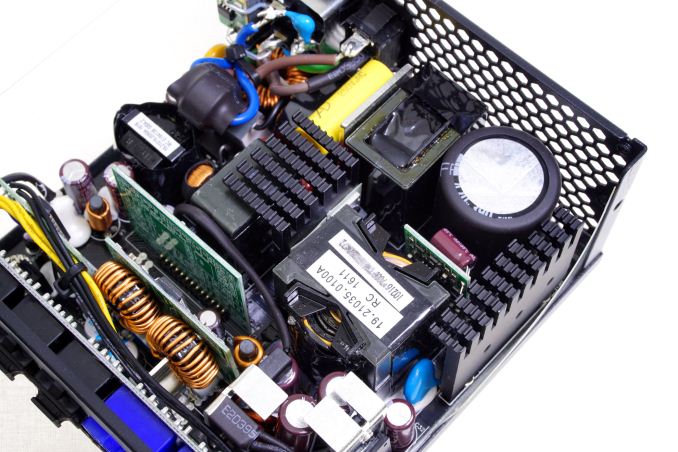
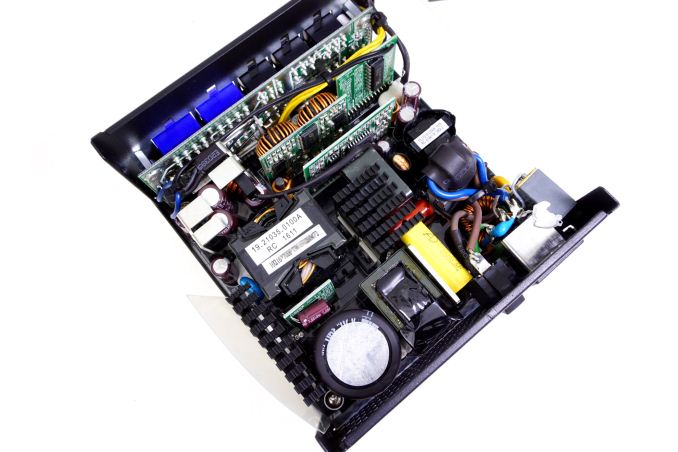
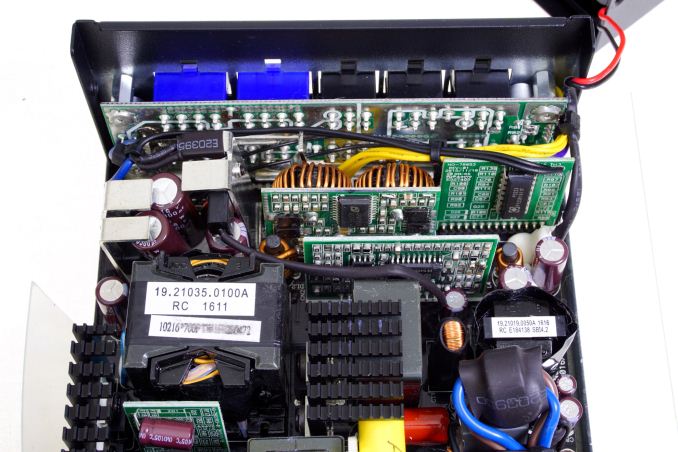








48 Comments
View All Comments
Eden-K121D - Friday, September 30, 2016 - link
Interesting product although I don't think anyone needs SFC PSUs of more than 500 Wattsedzieba - Friday, September 30, 2016 - link
Yoiu can cram a Titan and a X99 CPU into a 7.2L case (Dan A4) or a pair of them and an X99 into the Kimera Cerberus (18L) or LukeD's Project Orthus (12L), which would push exisitn 500W SFX PSUs out of their comfort zone.JoeyJoJo123 - Friday, September 30, 2016 - link
Dan A4 can use an SFX-L power supply, but a Titan (Pascal) + X99 CPU don't exceed 500W during load.Kimera Cerberus does use an SFX-L power supply, and extreme configurations can pull up 700w.
Project Orthus uses a 1U power supply. This power supply is incompatible.
The point people are making is that this product is a solution looking for a problem. SFX(-L) PSUs are typically used in small, portable PC cases. 500W units are sufficient for any 1 CPU + 1 GPU system, which is the vast majority of systems. Very few people need something that exceeds that.
wolfemane - Friday, September 30, 2016 - link
You are right, very few people need that. But there are those that may want to overclock both their CPUs and gpu's, and that can quit easily push power over 500w depending on the CPU, gpu, and overclock achieved in both. And doing all that in a small compact case is desirable by enough to bring a psu like this to market.JoeyJoJo123 - Friday, September 30, 2016 - link
Part of the problem with extreme overclocking in SFF is that (without introducing intolerable levels of noise) heat builds up very quickly in small volume. The typical SFF PCs, where SFX-L PSUs are typically used, has only intake fan(s) (if any case fans at all). So waste heat is dumped in a ~13 liter case (for cases like the ML07 or RVZ01 or FTZ01) and it can only passively leave the case.You can try to better force hot air out by using godly air pressure fans, such as the notoriously loud, high-rpm Delta fans, or the industrialPPC line of fans from Noctua, but you run into problems with noise generation.
I speak from experience here because I'm using three Noctua NF-F12 industrialPPC-3000 PWM case fans in my FTZ01, and a i5-4690k @4.5Ghz and GTX 970 (stock clocks). While I'm able to control the temperatures of my CPU well enough, the GPU compartment is a different issue, and the GPU can routinely hit ~90 degrees C after an hour or two of gaming, where it begins to throttle a bit. Part of that is my fault, as I bought the cheapest GTX 970 available at the time, which was an open air cooler and as a result it constantly recycles the warmer and warmer air it exhausts, but I don't believe a blower style GPU would help too significantly, either. And this happens even with using very high-pressure and high-rpm fans to try to force in as much positive case pressure as possible, to get stagnant exhaust air out of the case; it just doesn't work too well for my GPU so I leave it at stock clocks and undervolt it a bit.
SFF cases function best when GPUs aren't being overclocked, at the very least. They starve of fresh air too easily because the compromises of SFF cases don't allow the extra dimensions in the case to have enough case volume and fan (intakes and exhaust) to properly ensure that the GPU exhaust is leaving the case.
DanNeely - Friday, September 30, 2016 - link
Whenever you do replace your GPU I think you really should go with a blower cooler. While they're justifiably much maligned by enthusiasts with big well ventilated cases for bad noise to temperature performance in their beasts, one of the reasons why reference designs generally use blowers is that they allow the card to vent all of its unwanted heat directly without having to worry about if the rest of the case is able to help any or not. Looking at your case I think the blowers intake should line up with the perforated area in the GPU compartment allowing it to suck fresh air in from outside the case directly and blast it out the back.usernametaken76 - Saturday, October 1, 2016 - link
It's not "all" it's "most."Vayra - Monday, October 3, 2016 - link
Airflow and case cooling isn't rocket science. With only intake and open air GPU and CPU cooling things will get hot. All it takes is air *flow* my friend. One exhaust fan or a smart placement of a large CPU fan can already do the trick, you can waste however much you want on super expensive case fans that push a ton of air but if there is no exhaust, it's gonna fail.Flow of air (in-to-ex) > GPU cooler style (open > blower) > case fans.
Stick to that order for your next system in terms of cooling priority. Money better spent, lower temps.
TheinsanegamerN - Monday, October 3, 2016 - link
Never heard of positive air pressure? If you have fans only blowing in, plenty of heat will come out. Unless you sealed your entire chassis with duct tape.Also, LOL at a single GPU or CPU fan keeping up with the input of multiple case fans. Airflow doesnt work the way you think it works.
JoeyJoJo123 - Monday, October 3, 2016 - link
I don't believe you have any idea what you're talking about. The case is designed to have three fan placements, all designed to be intake-only. Additionally, the FTZ01 comes with fine-mesh fan filters.There is lots of air going in. The problem is that warm air doesn't leave as quickly as it is generated, and gets trapped in small compartments inside the case. After several hours, it gets very toasty inside the small enclosure.
This has nothing to do with my intelligence or the way I built the system, that's the _design_ of the case.